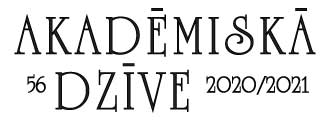Etiopiešu maltīte kā sakrālās ainavas veidošanas līdzeklis Hērodota Vēsturē
DOI:
https://doi.org/10.22364/adz.56.15Atslēgvārdi:
Hērodots, ainava, Kambīss, sakralitāte, uztursKopsavilkums
Kambīsa vēlme sasniegt Etiopiju, tikt pie etiopiešu ēdiena ir barjeras starp mirstīgajiem un nemirstīgajiem pārkāpums. Tie ir dievi, kas var sasniegt etiopiešus un to maltīti, nevis cilvēki
Atsauces
Baragwanath, E. (2008) Motivation and Narrative in Herodotus. New York : Oxford University Press.
Bosak-Schroeder, C. (2016) The Ecology of Health in Herodotus, Dicaearchus, and Agatharchides. Kennedy, F. R. (ed.). The Routledge Handbook of Identity and The Enviroment in the Classical and Medieval Worlds. London, New York : Routledge.
Bridgman, T. (2014) Hyperboreans: Myth and History in Celtic – Hellenic contacts. New York : Routledge.
Brown, S. T. (1982) Herodotus’ Portrait of Cambyses. Historia: Zeitschrift für Alte Geschichte, 31, 387–403.
Bull D.; Betancourt, P. P. (1999) Chemical Evidence Supporting the existence of a Structured Agricultural Manuring Regime on Pseira Island, Crete During the Minoan Age. Aegaeum, 20, 69–74.
Cole, G. S. (2004) Landscape, Gender, and Ritual Space: The Ancient Greek Experience. Berkeley : University of California Press.
Constantakopoulou, C. (2018) Landscape and Hunting: The Economy of the Eschatia. Land, 7, 1–12.
Desmond, W. (2004) Punishments and the Conclusion of Herodotus’ Histories. Greek, Roman, and Byzantine Studies, 44, 19–44.
Ekroth, G. (2007) Meat in Ancient Greece: Sacrificial, Sacred or Secular? Food & History, 5, 1, 249–272.
Finch, E. C. (2010) Evolving Views of Ageing and Longevity From Homer to Hippocrates. Greece & Rome, 57, 2, 355–377.
Finch, J. (2013) Historic landscapes. Howard, P. (ed.) The Routledge Companion to Landscape Studies. 2nd ed. New York : Routledge.
Fisher, N. (1992) Hybris. Warminster : Aris & Phillips.
Hutt, M. (2017) Nom Nom Nomoi: Food, Identity, and Shared Custom in Herodotus’ Histories, Master Thesis. Vancouver : University of British Columbia.
Karttunen, K. (2002) The Etnography of the Fringes. Bekker, J. E. (ed.). Brill’s Companion to Herodotus. Leiden, Boston : Brill.
Morin, M. K. (2009) Landscape: Representing and Interpreting the World. Clifford, J. N.; Holloway, L. S. (eds.) Key Concepts in Geography, 2nd ed. London : Sage.
Munson, R. (2014) Herodotus and Ethnicity. McInerney, J. (ed.). A Companion to Ethnicity in the Ancient Mediterranean. John Wiley & Sons.
Park, C. (2014) Religion and Geography. Hinnelis, J. (ed.) The Routledge Companion to the Study of Religion. London, New York : Routledge.
Roe, M. (2016) Editorial: food and landscape. Landscape Research, 41, 7, 709–713.
Romm, J. (1998) Herodotus. London : Yale University Press.
Skinner, E. J. (2012) The Invention of Greek Ethnography. New York : Oxford University Press.
Torok, L. (2014) Herodotus in Nubia. Leiden, Boston : Brill.
Vernant, J. P. (1979) Food in the Countries of the Sun. Vernant, J. P.; Detienne, M. (eds.). The Cuisine of Sacrifice among the Greeks. Chicago, London : University of Chicago Press.
Werblowsky, R. J. (1998) Introduction: Mindscape and Landscape. Kedar, B.; Werblowsky, R. J. (eds.) Sacred Space: Shrine, City, Land. New York : Palgrave.


